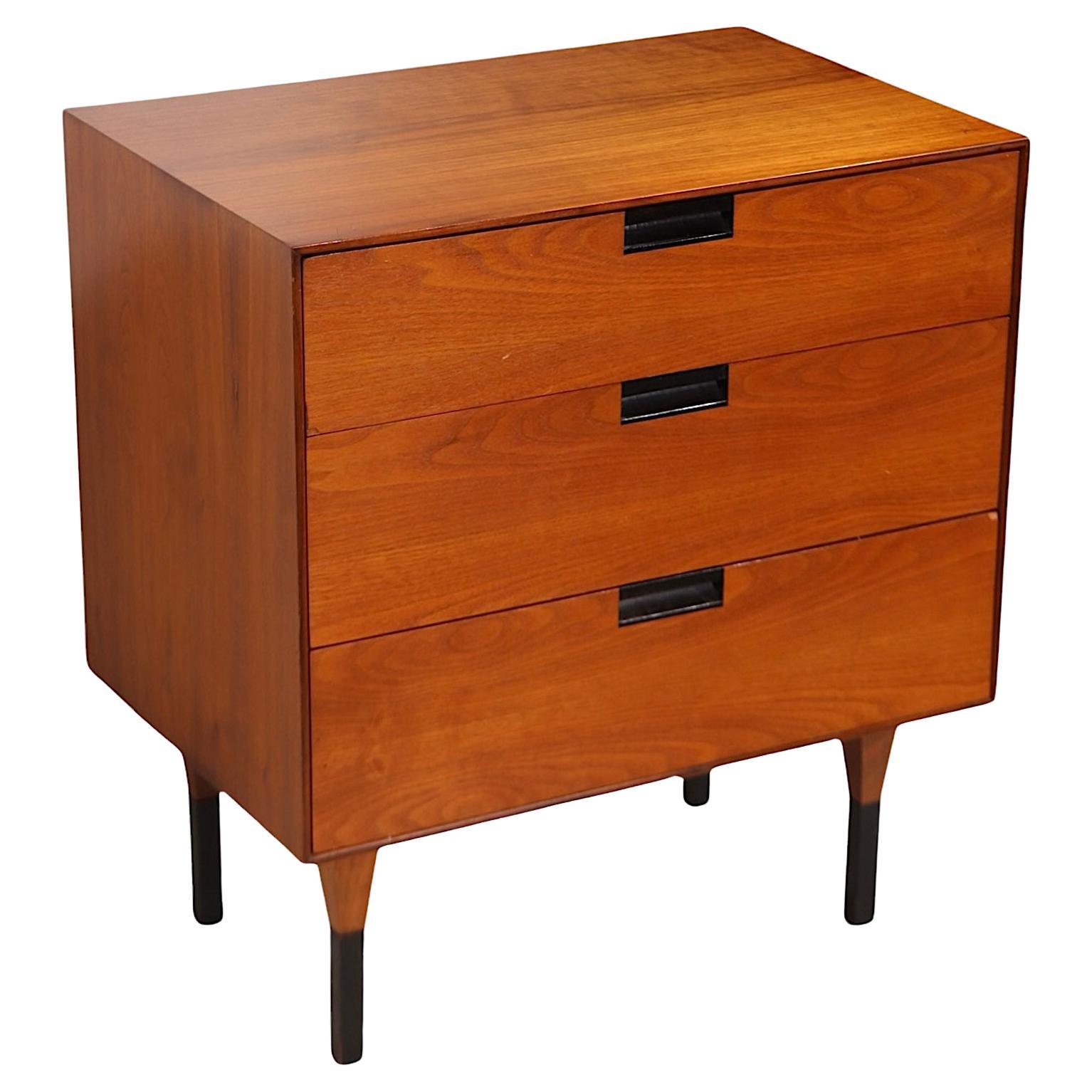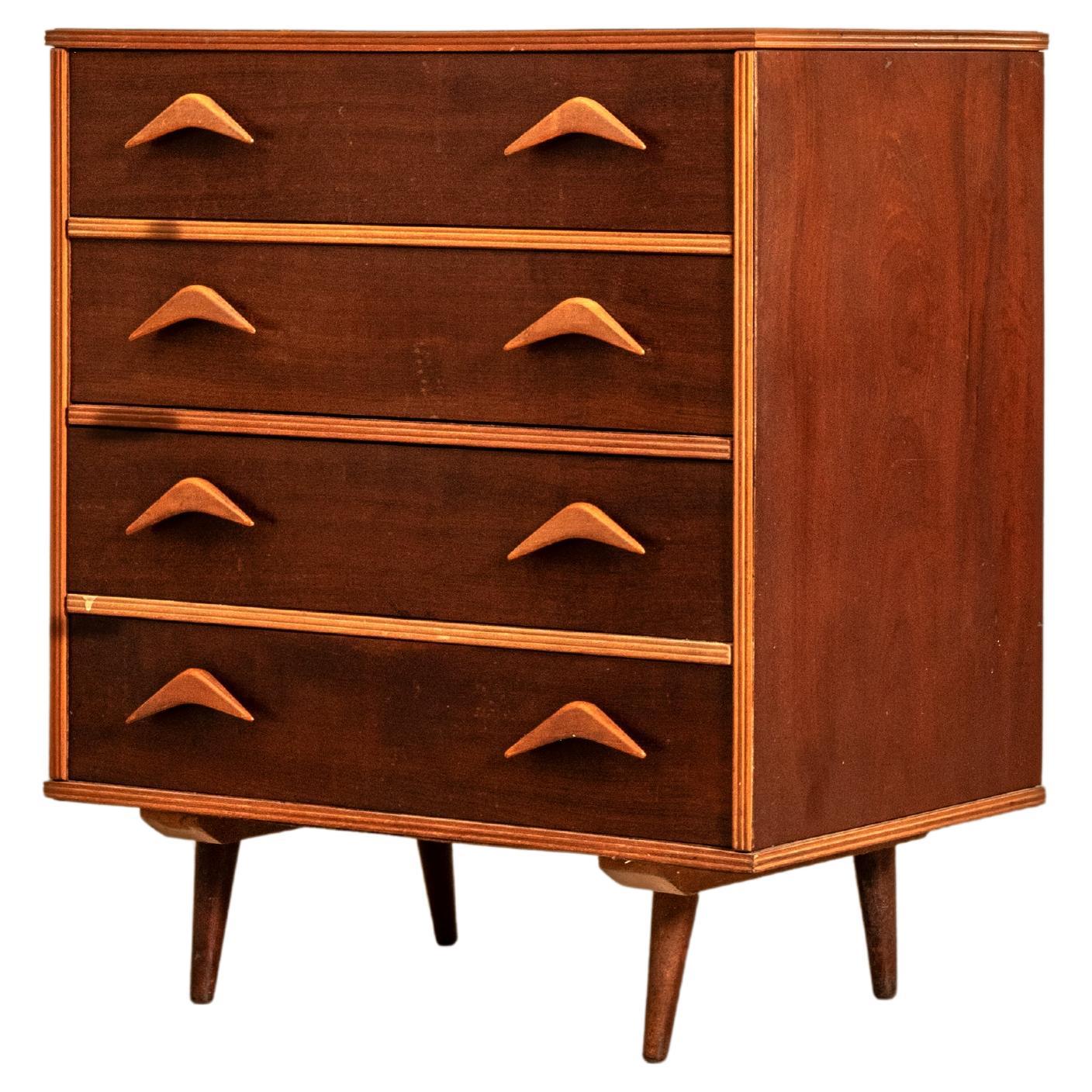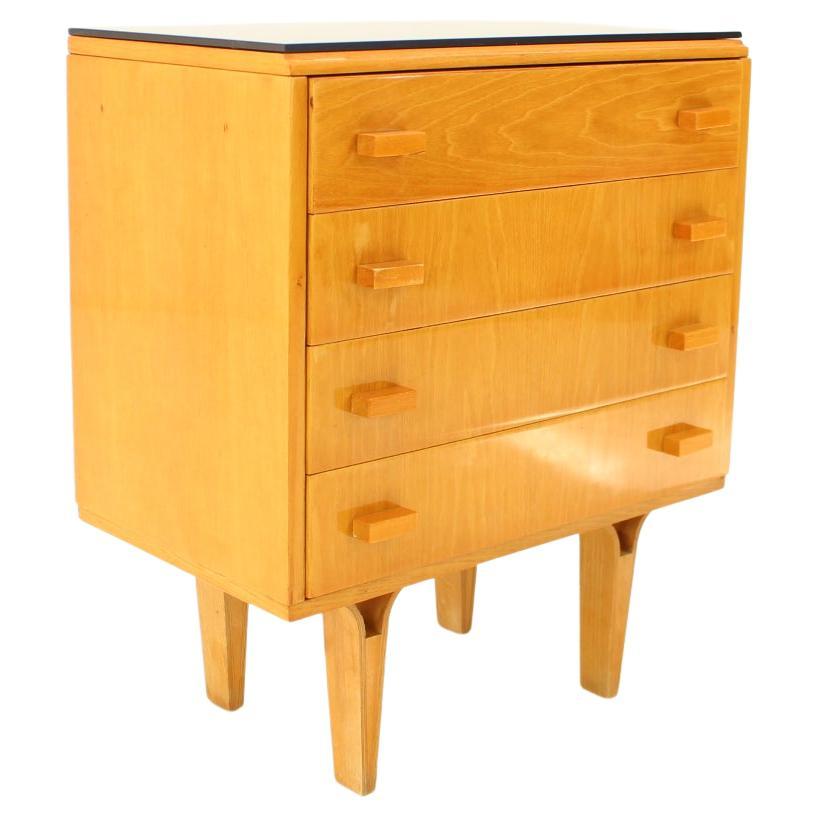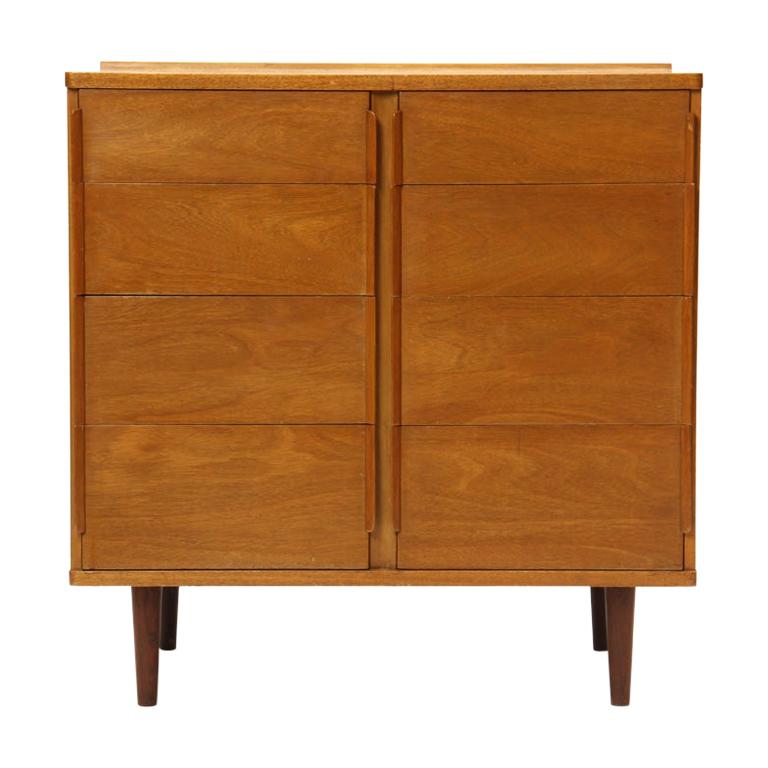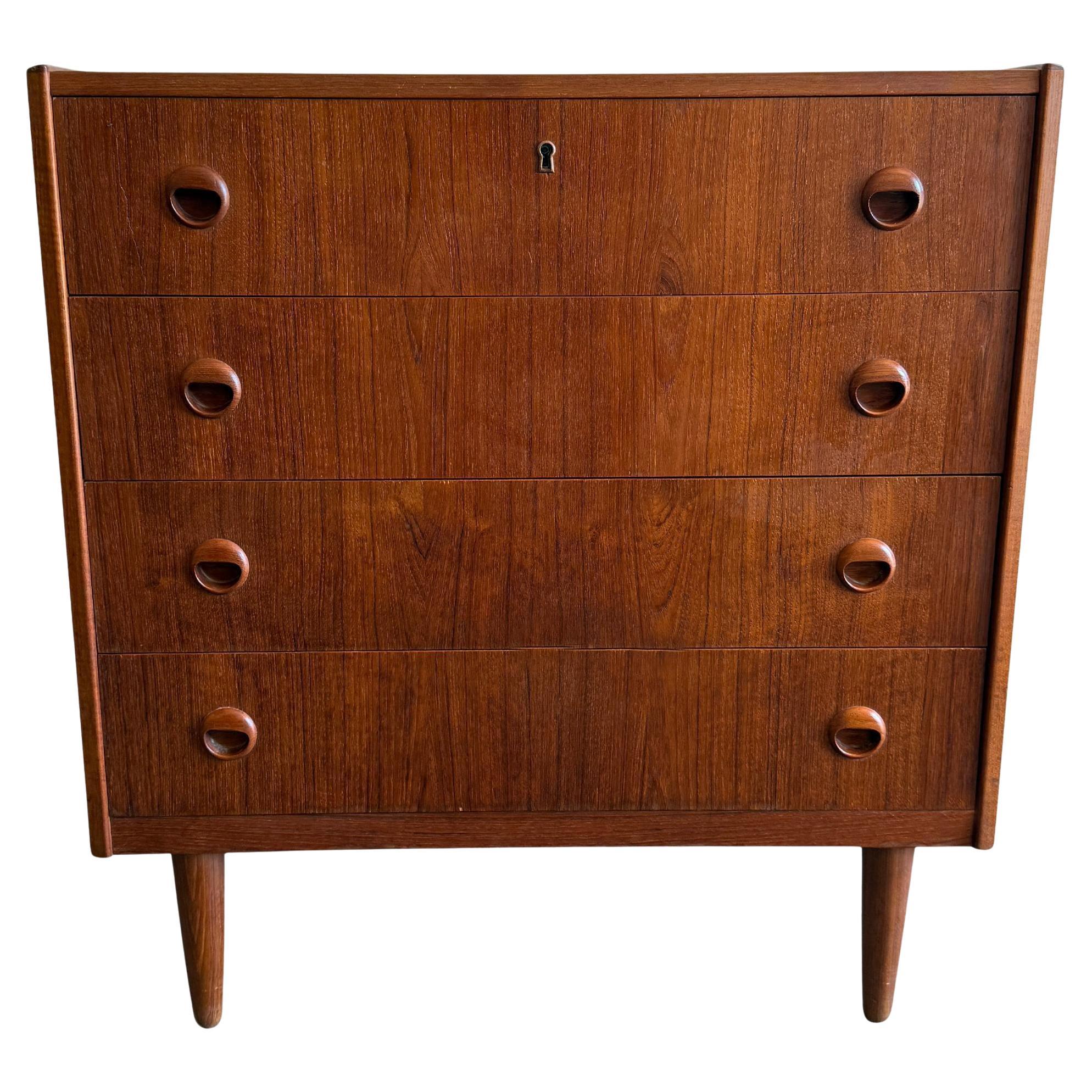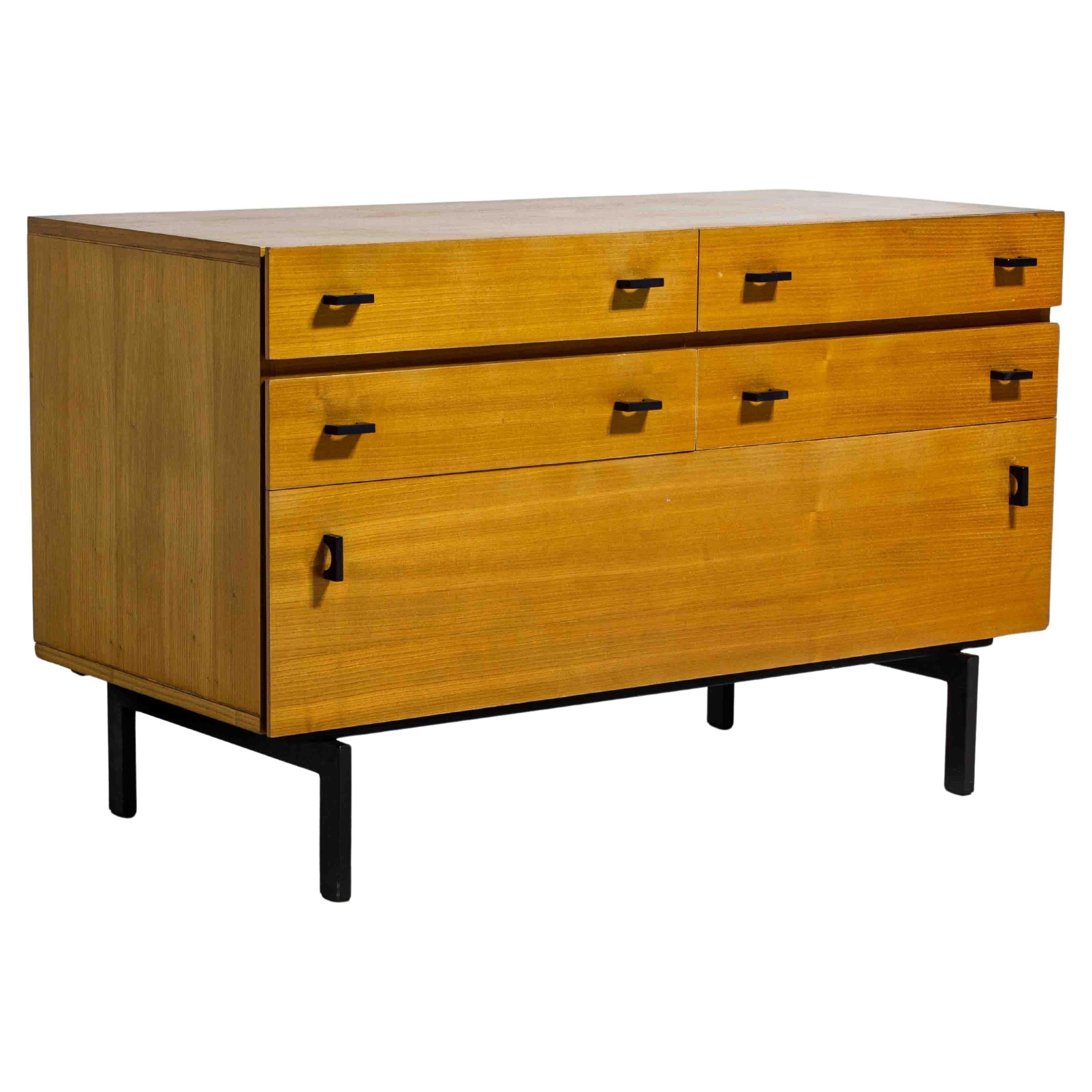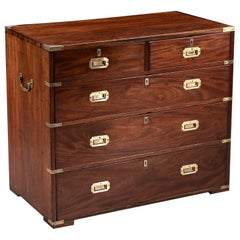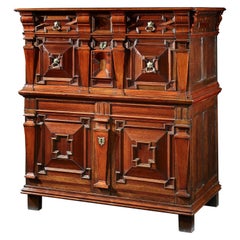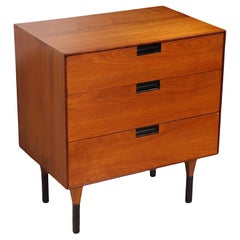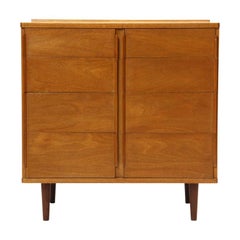Items Similar to Gilbert Rohde Dresser 4041 Kroehler New York World's Fair 1940 Two-Tone 44" long
Want more images or videos?
Request additional images or videos from the seller
1 of 9
Gilbert Rohde Dresser 4041 Kroehler New York World's Fair 1940 Two-Tone 44" long
$5,479.22
£4,000
€4,713.75
CA$7,528.74
A$8,426.08
CHF 4,397.77
MX$102,754.76
NOK 56,285.43
SEK 53,281.37
DKK 35,178.08
Shipping
Retrieving quote...The 1stDibs Promise:
Authenticity Guarantee,
Money-Back Guarantee,
24-Hour Cancellation
About the Item
Designer : Gilbert Rohde
Model ; Dresser 4041 Honeymoon Furniture for Young America,
Maker : Kroehler
Exhibited : 'America at Home' at the New York World's Fair 1940.
Created by Gilbert Rohde, 1940's foremost furniture designer, expressly to demonstrate modern living displayed in the 'America at Home' building at the New York World's Fair 1940.
Honeymoon furniture by Kroehler is outstanding in contemporary furniture design.
Notice its space saving compactness, its sturdiness, its freedom from dirt catching corners.
Honeymoon furniture offers comfort, convenience and economy never before possible in the small home or apartment
The use of two different coloured woods to create a two-tone effect is very striking and complements the simple form. This unusual chest of drawers is a signature piece that injects character into any interior.
The raised sides sit proud of the top elevating the chest creating an elegant tray effect. The front is fitted with three drawers with original wooden knobs in contrasting dark brown laurel. The sides have a projecting section of contrasting dark brown laurel at the front which defines the form. Inverted triangular feet. "Kroehler Made" metal tag. Designer unknown.
Kroehler
In 1902, Peter E. Kroehler bought the Naper ville Lounge Co., a maker of wooden lounge chairs and upholstered furniture. Kroehler built a new factory in Naperville in 1913 after the original facility was destroyed by a tornado. Soon thereafter, he renamed the company Kroehler Manufacturing Co. This enterprise soon operated across the country and employed several hundred men and women in the Chicago area. By the middle of the 1940s, with over $20 million in annual sales, Kroehler was the second-largest furniture maker in the United States. During the 1960s, when the company employed close to 8,000 people around the country, annual revenues passed $100 million. The company struggled during the 1970s, closing its historic Naperville factory in 1978 and ending its operations in the area. In 1981 Kroehler was acquired by the ATR Group of Northbrook, which put the company up for sale. By the early 2000s, furniture was still manufactured under the Kroehler name by two unrelated companies, one in North Carolina and the other in Ontario, Canada.
Gilbert Rhode : American, 1894 - 1944
Gilbert Rohde (1894-1944) is best known for helping to create the modern design at Herman Miller Inc. Gilbert Rohde furniture design was focused on mass production and bringing modern products to the greatest number of consumers. He is also credited with designing the first examples of biomorphic furniture in America-which would ultimately shape mid century modernism.
US industrial designer, born in New York. He became familiar with cabinetmaking in his father's shop. He studied at the Art Students League and Grand Central School of Art in New York. Early work was as a drama and music critic, cartooninst, reporter, and furniture illustrator. He traveled to France and Germany in 1927 and was inspired by modernism.
He opened his own office in New York in 1927, designing furniture and showrooms, and consulting with manufacturers like General Electric and Hudson Motor Car Company.
In 1931 HeywoodWakefield Company introduced a compact armless leatherette side chair with bentwood rear legs designed by Rohde, which sold 250,000 over the next eight years. Rohde also developed a later version for the Herman Miller Furniture Company, which was sold dis-assembled and made by what Rohde called an "automobile type of assembly."
By 1929 he had established a relationship with D.J. Depree, president of the Herman Miller Furniture Company in Zeeland, MI and prepared some designs for him. Dupree appointed him director of design there in 1932 as part of his decision to shift the company’s orientation from traditional to modern design. His first modern design for the company, a No. 2185 Group bedroom suite was shown at the Chicago Century of Progress.
Also in 1932, Rohde exhibited his furniture designs in a "Design for Machine" exhibit in Philadelphia, along with designs of Russel Wright. The Herman Miller Clock Company in 1933 introduced clocks designed by Rohde.
In 1934, Rohde was represented in a 1934 "Art and Industry" exhibit at Rockefeller Center organized by the National Alliance for Art and Industry that showed 1000 products by 100 designers, and in the Metropolitan Museum’s exhibit, "Contemporary American Industrial Art." One of his designs was the "Semi-Arm" chair, with bent chrome-plated steel tubular frame and leatherette seat and back.
Rohde was a member of the American Union of Decorative Artists and Craftsmen (AUDAC); was director of the Design Laboratory School from 1935-1938; was one of the founders of the Designers Institute of the American Furniture Mart in 1933; and headed an industrial design program at the New York University School of Architecture from 1939 to 1943.
He designed major exhibits for the New York Worlds Fair in 1939, including the Home Furnishing Pavilion, and the "Community Interests" exhibit in the Consumers Building.
In 1940, Rohde convinced the Herman Miller Furniture Company to discontinue production of all its period reproductions, because of his belief that imitation of traditional design was insincere esthetically. Rohde served at Herman Miller until his death in 1944. He was replaced by George Nelson, who continued to champion modern design at the company throughout the postwar period.
- Dimensions:Height: 32.49 in (82.5 cm)Width: 43.9 in (111.5 cm)Depth: 18.9 in (48 cm)
- Style:Mid-Century Modern (Of the Period)
- Materials and Techniques:Birdseye Maple,Joinery
- Place of Origin:
- Period:
- Date of Manufacture:c1940
- Condition:Wear consistent with age and use.
- Seller Location:BUNGAY, GB
- Reference Number:1stDibs: LU3867317153442
About the Seller
5.0
Vetted Professional Seller
Every seller passes strict standards for authenticity and reliability
Established in 1985
1stDibs seller since 2018
97 sales on 1stDibs
Typical response time: 7 hours
- ShippingRetrieving quote...Shipping from: BUNGAY, United Kingdom
- Return Policy
Authenticity Guarantee
In the unlikely event there’s an issue with an item’s authenticity, contact us within 1 year for a full refund. DetailsMoney-Back Guarantee
If your item is not as described, is damaged in transit, or does not arrive, contact us within 7 days for a full refund. Details24-Hour Cancellation
You have a 24-hour grace period in which to reconsider your purchase, with no questions asked.Vetted Professional Sellers
Our world-class sellers must adhere to strict standards for service and quality, maintaining the integrity of our listings.Price-Match Guarantee
If you find that a seller listed the same item for a lower price elsewhere, we’ll match it.Trusted Global Delivery
Our best-in-class carrier network provides specialized shipping options worldwide, including custom delivery.More From This Seller
View AllChest of Drawers Campaign Military Camphor Wood Brass 19th Century
Located in BUNGAY, SUFFOLK
Campaign Military or Travelling Chest of Drawers in Camphor Wood with Brass Detailing 19th Century
Unusual small size
Striking with the combination of richly coloured camphor wood a...
Category
Antique 1840s English Campaign Commodes and Chests of Drawers
Materials
Brass
Desk, Vintage, Mahogany, Gilding, Book-Spine Form Drawers, History of England
Located in BUNGAY, SUFFOLK
I have never seen a desk like this before, it is really quirky, a great conversation piece.
Tan leather top with gold leaf embossed tooling surrounded by crossbanding. The frieze wi...
Category
Vintage 1980s English Post-Modern Desks
Materials
Giltwood, Mahogany
Chest of Drawers Chest Commode Architectural Facade Enclosed Renaissance Cedar
Located in BUNGAY, SUFFOLK
A museum quality, English, Late-Renaissance, cedar enclosed chest of drawers with exceptional snakewood, walnut & oak with an architectural or façade front
This is the most sophisticated English model of chest of drawers conceived as a cabinet piece with an architectural front intended to disguise the drawers. This chest exhibits the mastery of English Late-Renaissance, cabinet making combining woods prized for their exoticism, color and beautiful figuring with carving and moulding in different ornamental patterns to simulate materials found within an architectural façade...
Category
Antique Early 17th Century European Renaissance Commodes and Chests of D...
Materials
Cedar
Commode Italian Venetian Baroque Burr Walnut Geometric Inlay Serpentine Front
Located in BUNGAY, SUFFOLK
The serpentine front on this magnificent commode is sophisticated and gives it gravitas. The undulating form is a masterpiece of carpentry.
The carpenter has used different woods fi...
Category
Antique 1720s Italian Baroque Commodes and Chests of Drawers
Materials
Walnut, Burl
Chest of Drawers Oak Cushion Moulding Panelled Bun Feet Drop Handles Vernacular
Located in BUNGAY, SUFFOLK
Lovely, characterful example of a good late-17th century oak chest of drawers with an exceptional lustrous and rich colour and patin...
Category
Antique 1660s English Baroque Commodes and Chests of Drawers
Materials
Oak
Bureau, 19th Century, English, Regency, Mahogany, Secret Drawers, Gallery
Located in BUNGAY, SUFFOLK
The top fitted with a removable gallery with fine brass filigree depicting lion heads and crowns amongst trailing stems. The mahogany, fall-front fitted with a later writing slope, a...
Category
Antique Early 19th Century English Regency Desks
Materials
Mahogany
You May Also Like
Diminutive Mid Century Three Drawer Dresser att. to Baughman for Directional
By Directional, Milo Baughman
Located in New York, NY
Exceptional mid century dresser, design att. to Milo Baughman for the Directional Furniture Company, circa 1950/60's. The walnut chest features three drawers, each with a recessed p...
Category
Mid-20th Century American Mid-Century Modern Commodes and Chests of Drawers
Materials
Walnut
1950's dresser with drawers, Móveis Cimo, Brazilian Mid-Century Modern Design
By Moveis Cimo
Located in Sao Paulo, SP
This exquisite chest of drawers was expertly crafted in the 1950s by the esteemed Brazilian manufacturer, Móveis Cimo. Renowned for their meticulous attention to detail and exception...
Category
Late 20th Century Brazilian Mid-Century Modern Commodes and Chests of Dr...
Materials
Wood
1970 Chest of Drawers by Novy Domov, Czechoslovakia
By Novy Domov
Located in Praha, CZ
Vintage chest of drawers made in high gloss. Made in Czechoslovakia in Nový Home (marked) in the 1970s. Good original condition, marks used.
Category
Vintage 1970s Czech Mid-Century Modern Commodes and Chests of Drawers
Materials
Wood
Chest of Drawers by Edward Wormley for Dunbar
By Dunbar Furniture, Edward Wormley
Located in Sagaponack, NY
An elegant and well proportioned eight (8) drawer bleached mahogany cabinet having distinctive laminated end pulls, on tapered dowel legs.
Category
Vintage 1950s American Mid-Century Modern Commodes and Chests of Drawers
Materials
Mahogany
Mid century danish modern small 4 drawer low teak dresser on legs
By Folke Ohlsson
Located in Brooklyn, NY
Mid century danish modern small 4 drawer low teak dresser on 4 legs in the style of Folke Ohlsson. Very nice construction with Solid Birch drawers that are super clean and slide smoo...
Category
Vintage 1960s Danish Mid-Century Modern Dressers
Materials
Birch, Teak
$1,600 Sale Price
20% Off
Chest of drawers in beech wood by Roger de Winter, 1960s Belgium
Located in Antwerpen, VAN
This beech wood chest of drawers was designed by Belgian architect Roger De Winter. It features his signature semi-circle handles and a clean, functional design. The piece sits on a ...
Category
Vintage 1960s Belgian Mid-Century Modern Cabinets
Materials
Beech
More Ways To Browse
World Fair Furniture
1960s New York Furniture
Vintage Worlds Fair
1939 Fair
1939 World Fair
New York Worlds Fair 1939
Piece Of Eight
1970s Maple Chairs
Canadian Maple Chairs
Vintage Country Fair
Vintage 1939 New York Worlds Fair
American Of Chicago Furniture
Biomorphic Furniture
Used Furniture North York
Industrial Metal Drawers
General Electric Vintage
Vintage World Clock
Metal Cabinet Drawers Industrial
